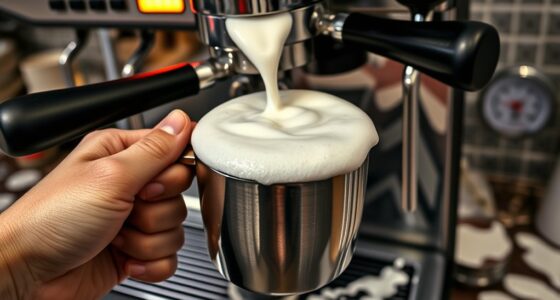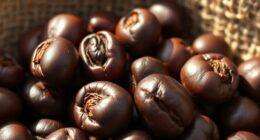To avoid common cappuccino-making mistakes, use fresh, properly ground coffee suited for espresso to guarantee balanced flavor and extraction within 20-35 seconds. Always preheat your cup to keep drinks hot, and master frothing milk to create smooth microfoam without bubbles. Be careful not to overheat milk, and maintain the correct coffee-to-milk ratios. Focusing on these details will help you craft a better cappuccino—stay tuned to learn more tips for perfecting your technique.
Key Takeaways
- Use fresh, properly ground coffee suited for espresso to ensure balanced extraction and flavor.
- Froth milk to a smooth microfoam without large bubbles and avoid overheating beyond 170°F.
- Preheat cups to maintain temperature and preserve aroma and flavor in the final drink.
- Extract espresso within 20-35 seconds to prevent weak or overly bitter flavors.
- Maintain correct coffee-to-milk ratios for authentic taste, texture, and appealing presentation.

Making a perfect cappuccino might seem straightforward, but common mistakes can ruin the drink’s flavor and texture. If you’re trying to make a cappuccino at home, it’s easy to fall into pitfalls that compromise the quality. Knowing the mistakes to avoid can help you craft a better cup every time.
One of the most frequent errors is using low-quality beans or grinding them improperly. If your beans are stale or your grind is too coarse or fine, your espresso will either taste weak or bitter, affecting the overall balance of your cappuccino. To make a truly great cappuccino, you need fresh beans and a consistent grind size suited for espresso brewing.
Another common mistake involves the milk. Many people overlook the importance of properly frothing the milk. When you steam the milk, it’s crucial to heat it correctly. Overheating above 170°F (77°C) causes scorching, which not only ruins the milk’s flavor but also hampers the development of good microfoam.
The goal is to create smooth, velvety froth, not large bubbles or burnt milk. Using the steam wand properly is essential—immerse the wand just below the surface of the milk to introduce air and then submerge it deeper to heat evenly. This technique guarantees you froth the milk to the right consistency, avoiding common mistakes like over-foaming or under-heating, which can make your cappuccino less authentic.
Preheating your cup is another step many skip, but it’s indispensable for maintaining the right temperature. When you pour hot espresso into a cold cup, it cools rapidly, diminishing flavor and making the drink less enjoyable. Always warm your cup beforehand to keep the heat locked in, preserving the temperature and flavor profile.
Getting the coffee-to-water ratio right is also essential. Poor extraction times—less than 20 seconds or over 35 seconds—can lead to weak or overly bitter espresso, respectively. This impacts the overall taste of your cappuccino.
Additionally, the milk-to-espresso ratio should be balanced; too much milk or too little foam results in a less authentic appearance and flavor. The traditional cappuccino features equal parts espresso, steamed milk, and foam, which you should aim to replicate for the best results.
Frequently Asked Questions
What Is the Secret to a Good Cappuccino?
The secret to a good cappuccino is mastering the perfect balance of espresso, steamed milk, and microfoam. You should use fresh beans and aim for a 1:1:1 ratio, ensuring each component complements the others.
Pay attention to milk frothing—aim for smooth, velvety microfoam at about 150°F. Preheat your cup and keep your water at the right temperature to enhance flavor.
With practice, you’ll create a beautifully crafted cappuccino every time.
What Is the Correct Way to Make a Cappuccino?
To make a proper cappuccino, start by extracting 25-30 ml of espresso at 195-205°F with a 1:2 coffee-to-water ratio.
Froth cold whole milk to 55-60°C, creating glossy microfoam.
Preheat your cup, then pour the milk with a controlled flow to form balanced layers.
Use fresh beans, a medium-fine grind, and precise temperature regulation to guarantee a rich, well-structured cappuccino.
Do Italians Put Sugar in Cappuccino?
You might wonder if Italians put sugar in cappuccinos. Generally, they don’t. Italians prefer drinking their cappuccino plain, especially in the morning, to enjoy the coffee’s natural flavors.
If someone adds sugar, it’s usually after tasting the drink first, not mixed in from the start. So, to respect the tradition, avoid adding sugar directly into your cappuccino and savor the authentic taste.
Why Is My Cappuccino Not Strong Enough?
If your cappuccino isn’t strong enough, you might be using too much water during extraction, which dilutes the flavor. Check if your brewing time is too short or if your machine isn’t applying enough pressure.
Also, make certain you’re using fresh, high-quality beans and a fine grind. Adjust these factors to enhance the coffee’s strength, making your cappuccino richer and more satisfying.
Conclusion
To perfect your cappuccino, avoid common mistakes like overfilling the cup or steaming the milk incorrectly. Pay attention to each step, from selecting quality beans to mastering the milk frothing technique. Practice makes perfect, so don’t get discouraged if it’s not perfect right away. Keep experimenting, stay patient, and you’ll soon enjoy a beautifully crafted cappuccino every time. Remember, small adjustments make a big difference in your coffee-making skills.









